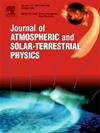印度两个低纬度站大气电场变化及其与空气质量指数的相关性
IF 1.9
4区 地球科学
Q3 GEOCHEMISTRY & GEOPHYSICS
Journal of Atmospheric and Solar-Terrestrial Physics
Pub Date : 2025-04-24
DOI:10.1016/j.jastp.2025.106505
引用次数: 0
摘要
大气电场(AEF)变化及其与空气质量指标(如空气质量指数(AQI))的关系对于了解局部AEF和全球电路(GEC)行为至关重要。本文研究了印度西孟加拉邦Bagula (BGL)和Purulia (PRL)两个不同地点AEF的日变化和季节变化。将这些站点的天气AEF变化与全球标准卡内基曲线和其他全球站点进行比较。与表现出明显偏离卡内基曲线的城市站点相比,农村站点的晴天平均日变化显示出明显的GEC信号。分析了空气污染系数随空气质量指数和颗粒物的变化规律,评价了当地空气污染对大气电力的影响。AEF与AQI在不同季节间呈中强相关。在冬季(r = 0.75)、季风后季节(r = 0.59)和季风后季节(r = 0.63), AEF的季节变化与AQI有很强的联系。季风季节在两个站点的相关性最低。在极端污染时期,空气质量指数与空气质量指数在日尺度上呈显著负相关,表明负空间电荷层的形成改变了空气质量指数。结果表明,在高污染期,可以通过空气质量指数来估计空气质量指数。本文章由计算机程序翻译,如有差异,请以英文原文为准。
Atmospheric electric field variations and its correlation with air quality index as observed from two low-latitude Indian stations
Atmospheric electric field (AEF) variations and their relationship with air quality indicators like the Air Quality Index (AQI) are vital in understanding both local AEF and global electric circuit (GEC) behaviors. The present study investigates the diurnal and seasonal variations of AEF at two different locations in West Bengal, India: Bagula (BGL) and Purulia (PRL). The fair weather AEF variations from these sites are compared with the global standard Carnegie curve and with other global sites. Compared to the urban site, which exhibits notable departures from the Carnegie curve, the fair-weather mean diurnal variation at the rural site displays distinct GEC signals. The AEF variations are also analyzed with respect to the AQI, and particulate matter in those two sites to evaluate the impact of local air pollution on atmospheric electricity. Moderate to strong correlations between AEF and AQI across different seasons are obtained. The seasonal AEF variation and AQI have a strong link for the winter season (r = 0.75), the post-monsoon season (r = 0.59) at BGL, and the post-monsoon season (r = 0.63) at PRL. The monsoon season experienced the lowest correlation in both sites. The AEF exhibits a strongly negative association with the AQI on a daily scale during periods of extreme pollution in both sites, suggesting the formation of a negative space charge layer that modifies AEF. Results indicate the possibility of estimating AQI values from the AEF measurements during high episodes of pollution.
求助全文
通过发布文献求助,成功后即可免费获取论文全文。
去求助
来源期刊

Journal of Atmospheric and Solar-Terrestrial Physics
地学-地球化学与地球物理
CiteScore
4.10
自引率
5.30%
发文量
95
审稿时长
6 months
期刊介绍:
The Journal of Atmospheric and Solar-Terrestrial Physics (JASTP) is an international journal concerned with the inter-disciplinary science of the Earth''s atmospheric and space environment, especially the highly varied and highly variable physical phenomena that occur in this natural laboratory and the processes that couple them.
The journal covers the physical processes operating in the troposphere, stratosphere, mesosphere, thermosphere, ionosphere, magnetosphere, the Sun, interplanetary medium, and heliosphere. Phenomena occurring in other "spheres", solar influences on climate, and supporting laboratory measurements are also considered. The journal deals especially with the coupling between the different regions.
Solar flares, coronal mass ejections, and other energetic events on the Sun create interesting and important perturbations in the near-Earth space environment. The physics of such "space weather" is central to the Journal of Atmospheric and Solar-Terrestrial Physics and the journal welcomes papers that lead in the direction of a predictive understanding of the coupled system. Regarding the upper atmosphere, the subjects of aeronomy, geomagnetism and geoelectricity, auroral phenomena, radio wave propagation, and plasma instabilities, are examples within the broad field of solar-terrestrial physics which emphasise the energy exchange between the solar wind, the magnetospheric and ionospheric plasmas, and the neutral gas. In the lower atmosphere, topics covered range from mesoscale to global scale dynamics, to atmospheric electricity, lightning and its effects, and to anthropogenic changes.
 求助内容:
求助内容: 应助结果提醒方式:
应助结果提醒方式:


